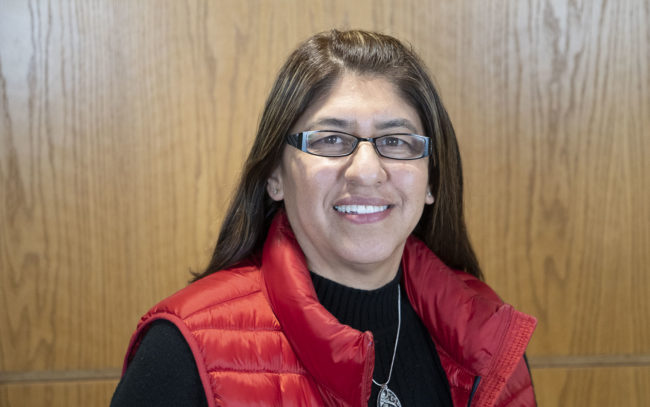
Blanca Mejia is the founder and executive director of Generation Diamond.
Generation Diamond operates the only free or low-cost tattoo removal program in the state of Nebraska. And it’s run by Blanca Mejia, whose nonprofit organization provides a variety of services in addition to tattoo removal.
A lawyer in Mexico, Blanca immigrated to the U.S. 20 years ago. After a career as a legal assistant in Omaha, she retired and launched Generation Diamond in 2016 to help people in reentry and those who are homeless. It provides hot meals three days per week, as well as showers, clothing and a GED program.
Inspired to do tattoo removals by son’s friend
Blanca was compelled to add tattoo removal to Generation Diamond’s services when she saw a friend of her son’s, who was so covered in tattoos that he was hardly recognizable. She knew that he had dropped out of high school, his mom had kicked him out of the house, and he had to pay child support. “Overall, his life was really bad,” she says.
Recognizing that tattoos were holding him – and many others – back – Blanca was inspired to do tattoo removals and met Mark Drevno, Jails to Jobs executive director, at the Global Homeboy Network gathering in 2019.
“I talked to her about tattoo removal, sent her a copy of our book, Tattoo Removal: Establishing a Free or Low-Cost Community-Based Program, A How-to Guide, and a second copy to her medical director. I also introduced her to Astanza, a laser device company that offers discounts and support to nonprofits, and supported her with technical assistance through emails and phone calls,” he says.
Bought Astanza laser device with donations
As a result, Blanca decided to pursue her new venture and learn how to do tattoo removals. And she bought the Astanza laser device with donations to her organization.
“Generation Diamond was supposed to have many programs last year, but because of Covid-19 everything was closed. We had money for the programs, but didn’t use it and were told it could be used for whatever we wanted. So we bought the equipment with that money,” Blanca says.
In September 2020, Astanza conducted a two-day training program for her and a group of about 10 volunteers, including the doctor who serves as their medical director. Although she does most of the removals, three other people have helped her out.
She felt supported by Drevno and Opal Taskila, her Astanza account manager. “Mark has been a very good mentor. He was always willing to talk to me. Opal also helped me. I felt like someone was holding my hand,” she says.
The tattoo removal service is provided on Tuesdays and Thursdays from 9 a.m. to 7:30 p.m. Most clients, however, want to come after work. And beginning this month Blanca plans to do tattoo removals on a daily basis.
The tattoo removal is limited to tattoos on the face, neck or arms – anything that prevents them from getting a job. She also takes tattoos off of trafficked women.
“We also have a guy who was sentenced to 20 years, but because of Covid they just gave him six years. He has tattoos all over his face, and we’re helping him (for his safety and well being before he goes to prison),” she says.
Treatments are free to those in reentry
Treatments are free for those who have just been released. “If they have a job we charge $20 or $40. The maximum is $60 per treatment, depending on the size. But only two people have paid so far,” Blanca says.
Although, because of Covid, there have been no requirements for participants, starting this month, they will have to do two hours of community service. Blanca feels that “they should give something back to the community.”
The Generation Diamond tattoo removal program is supported by a host of volunteers. “In addition to the people who do tattoo removals, we have volunteers who come in to make the phone calls, keep the records and make fliers,” she says.
Word of mouth proves best promotion tool
People find out about the program through word of mouth. Blanca puts fliers around the community and at the plasma donation center, the source of many of her clients. Although Generation Diamond has a Facebook page, only one or two people have found out about the program that way.
“When we ask people how they know about us, they say they heard from their friends,” she says.
And the general public finds her in other ways. A recent visitor was Doug Koebernick, the inspector general of the Nebraska Correctional System, who saw her program on the news.
And what would she tell others who might be thinking of starting a tattoo removal program?
“It’s a very beautiful amazing program. You change people’s lives,” Blanca says. “I ask them why don’t you want this tattoo anymore, and they say it brings back bad memories. Not only are you removing the tattoo, but you are changing the lives of people. I was doing the tattoo removal of a woman and she was crying. I thought she was in pain. But she said that her boyfriend forced her to get tattooed, and she wanted to get it taken off.”
Interested in starting a community-based tattoo removal program?
For complimentary technical assistance and a free electronic copy of our book, Tattoo Removal: Establishing a Free or Low-Cost Community-Based Program, A How-to Guide, contact us. You can also check out our website for links to articles about tattoo removal programs and how to launch one.


I too have been removing inappropriate tattoos for 16 years without any financial support. Why? Because you can’t get a job with inappropriate tats on your face, hands or neck.
Praying for a Grants so I can get a mobile unit to visit prisons and any other program that might want to offer removal.